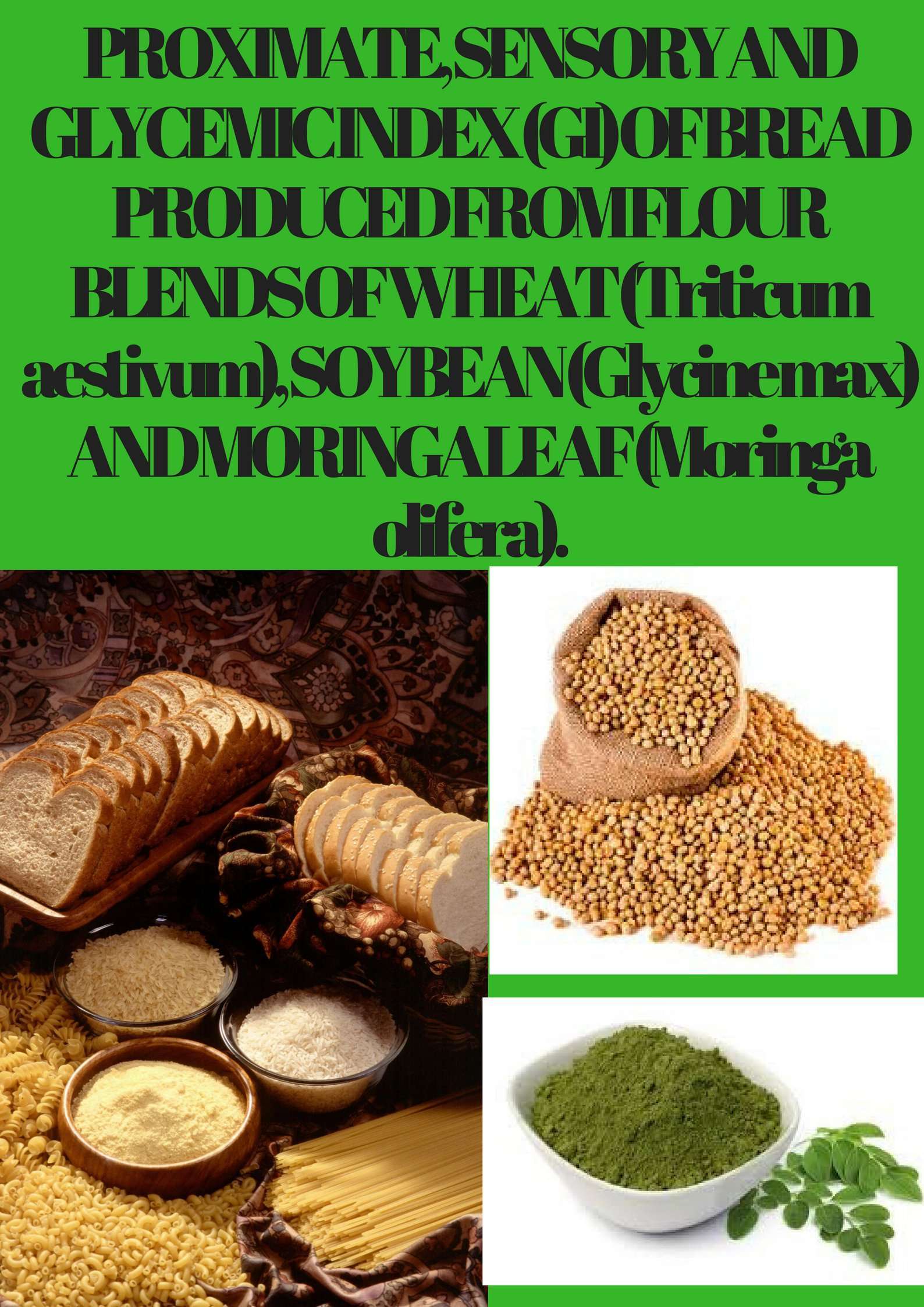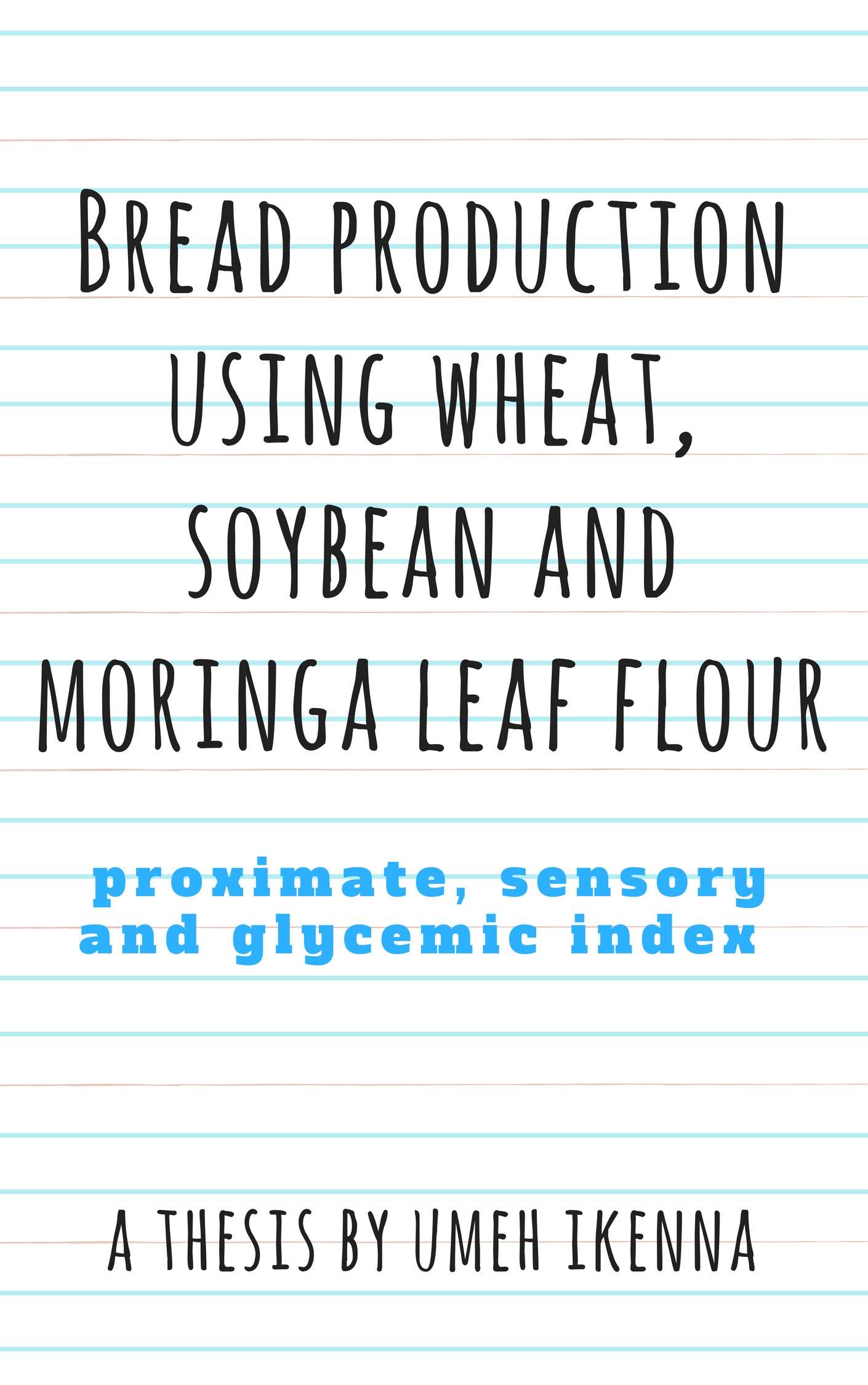ABSTRACT: This study investigated the proximate composition, sensory evaluation and glycemic index (GI) of bread produced from flour blends of wheat, soybean and moringa leaf. Soybean and moringa leaf were converted into flour and were used together with wheat flour in the different composite formulation in the production of bread (WSM01- WSM04). The GI of the bread samples was calculated by dividing the incremental area under the glucose response curve of the test food by the incremental area under the glucose response curve for the reference food and multiplying the result by 100. Six non-smoking volunteers (3 women and 3 men of mean age 24.5±1.04, range 23-26, mean body mass index (BMI) 20.09±1.50 kg/m2, range 18.35-21.73kg/m2) were recruited and after overnight fast each was fed with 71.6g (control sample) and 88.8g (80:10:10 of wheat, soybean, moringa leaf flour bread (WSM01) sample) and volunteers were fed with 50g anhydrous glucose on different days. Capillary blood samples were taken at 15, 30, 45, 60, 90 and 120 min after starting to eat for the test and reference food. A glucose response curve was drawn and the area under the curve was calculated by the trapezoid method. The glycemic index was defined as the glucose incremental area under the glucose response curve of a test meal expressed as a percentage of the glucose incremental area under the glucose response curve of the reference food. The proximate analysis showed a great decrease with a significant difference (p<0.05) in the carbohydrate content of the bread samples from 69.80% (control sample) to 29.03% (WSM04 sample) and an increase in the protein content of the bread samples. The sensory evaluation of the bread samples indicated lower mean scores were recorded for samples containing soybean and moringa leaf flour than the control sample in most of the attributes tested. WSM01 samples were most preferred, having mean scores of 5.40, 5.70, 4.80, 6.10, 5.90 and 5.90 in the attributes of colour, taste, flavor, aroma, mouthfeel/texture, appearance, and general acceptability, respectively. The glycemic index (GI) of the control sample and WSM01 were found to be 87.65 and 69.71 respectively. The analysis of variance (F= 0.05) carried out showed that the blending of the flour with soybean and moringa leaf affected the glycemic indices of the food, there was also a significant difference (p< 0.05) between the control sample and WSM01 sample. This study concludes that the compositing of flour in the production of bread improved the nutritional values of the flour and reduced carbohydrate content thereby reducing the glycemic index.
PROXIMATE, SENSORY AND GLYCEMIC INDEX (GI) OF BREAD PRODUCED FROM FLOUR BLENDS OF WHEAT (Triticum aestivum), SOYBEAN (Glycine max) AND MORINGA LEAF (Moringa olifera).
GET MORE RELATING FOOD SCIENCE AND TECHNOLOGY PRODUCT
CHAPTER ONE
Background to the Study
Diabetes mellitus (DM) is an aetiologically multifactorial metabolic disorder, characterized by chronic hyperglycemia. It results in aberrations in carbohydrate, fat and protein metabolism, which arise due to defects in insulin secretion, and/or action. DM is currently a very prevalent disease, especially in Africa (Bos and Agyemang, 2013; Beverley and Eschwège, 2003).
Globally, at the end of 2013, as much as 382 million people had the disease; while the number is expected to reach 592 million by 2035. Interestingly, the burden of diabetes is highest in low and middle income countries (LMICs). (It is reported that in 2011, for instance, 14 million Africans had diabetes; and 80% of diabetics currently live in LMICs) (IDF, 2013; Van Dieren et al., 2010; Chow et al., 2006). LMICs will experience significant increases in the prevalence of the disease over the next 22 years (Guariguata et al., 2014).
Controlling blood sugar (glucose) levels has been a major problem and goal of diabetes treatment, in order to prevent complications of the disease. Type 1 diabetes is managed with insulin as well as dietary changes and exercise. Type 2 diabetes may be managed with non-insulin medications, insulin, weight reduction, or dietary changes (Ferry, 2016). Foods with low glycemic index (GI) and glycemic load (GL) raise blood sugar more slowly than high glycemic index/load foods. Glycemic index refers to a standardized measurement, while glycemic load takes a typical portion size into account (Ferry, 2016).
The GI and GL of food depend on amount and chemical nature of carbohydrates consumed, such as monosaccharide absorbed (glucose, fructose, galactose) and nature of the starch (amylose, amylopectin, resistant starch), but the GI is also affected by several different factors such as plant variety, storage, processing, and cooking of foods (Liljeberg et al. 1992, Järvi et al. 1995, Soh and Brand-Miller 1999, Östman et al. 2001, Leeman et al. 2005). Adherence to a diabetic diet is a critical aspect of controlling blood sugar in people with diabetes. When considering an ideal diabetic diet, a number of factors must be taken into consideration, including the amount and type of carbohydrates consumed as well as the amount of fiber, fat, and protein contained in foods.
Wheat provides nearly 55% of carbohydrate and 20% of the food calories. It contains carbohydrate 78.10%, protein 14.70%, fat 2.10%, minerals 2.10% and considerable proportions of vitamins (thiamine and Vitamin-B) and minerals (zinc, iron) per 100g edible portion (Adams et al., 2002).
According to Wolf and Cowan (1977), commercial soybeans constitute approximately 8% cotyledon, and 2% hypocotyl and plumule. Protein content of 40%, fat 21%, carbohydrate 34%, ash 4.9% in a whole bean per 100g edible portion.
According to Kasolo et al. (2010), the leaves of M. oleifera are rich in minerals like calcium, potassium, zinc, magnesium, iron and copper. Vitamins like beta-carotene of vitamin A, vitamin B such as folic acid, pyridoxine and nicotinic acid, vitamin C, D and E also present in M. oleifera (Mbikay, 2012). Moringa leaves also have a low calorific value and can be used in the diet of the obese.
Statement of the problem
Bread is a staple food prepared from a dough of wheat flour and water and usually consumed by a larger population (Cauvain and Stanley, 2015). However, due to the high calorific value of the flour used in the production of bread, it has a high glycemic index (Adams et al., 2002). Furthermore, the high GI leads to high increase in blood glucose (Ferry, 2016). Therefore, there is a need to reduce the GI of bread by fortification with other flour.
Significance of the study
The glycemic index (GI), first proposed in 1981, is a system of classifying food items by glycemic response. Over the past 36 years, low- glycemic index diets have been associated with decreased risk of cardiovascular disease, type 2 diabetes, metabolic syndrome, stroke, depression, chronic kidney disease, formation of gall stones, neural tube defects, formation of uterine fibroids, and cancers of the breast, colon, prostate, and pancreas. Taking advantage of these potential health benefits can be as simple as sticking with whole, natural foods that are either low or very low in their glycemic index value. The study is important for diabetes and weight management.
To bring literature surveys showing that there is little or no knowledge about the glycemic index of bread made from composite flour of wheat, soybean and moringa leaf. Therefore, the aim of this study was to explore the pattern of glycemic index of commonly consumed bread (control) to the enriched bread, so that it may generate some useful information for health professionals during the management of certain disease such as diabetes mellitus.
Aim/ Objectives of the study
Major Objectives
The major objective of this research is to evaluate the proximate composition, sensory attribute and the glycemic index (GI) of bread produced from flour blends of wheat, soybean, and carrot.
Specific Research Objectives
- To assess the proximate composition of the bread products from flour blends of wheat, soybean, and carrot.
- To attain the sensory attribute of the bread produced from flour blends of wheat, soybean, and carrot.
- To determine the GI of bread produced from flour blends of wheat, soybean, and carrot.
- To determine the best composition of the flour that would have a good sensory attribute with a low GI.





Reviews
There are no reviews yet.